Lysosomal Storage Disease Treatment Market Size
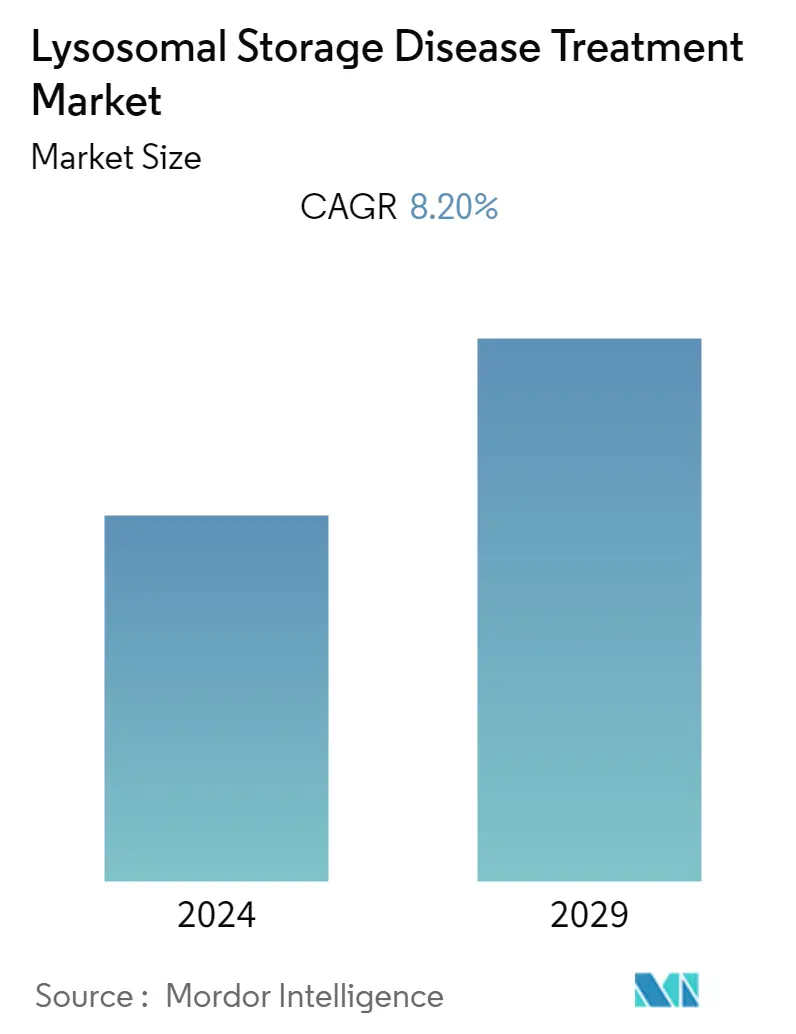
| Study Period | 2021 - 2029 |
| Base Year For Estimation | 2023 |
| CAGR | 8.20 % |
| Fastest Growing Market | Asia Pacific |
| Largest Market | North America |
| Market Concentration | Medium |
Major Players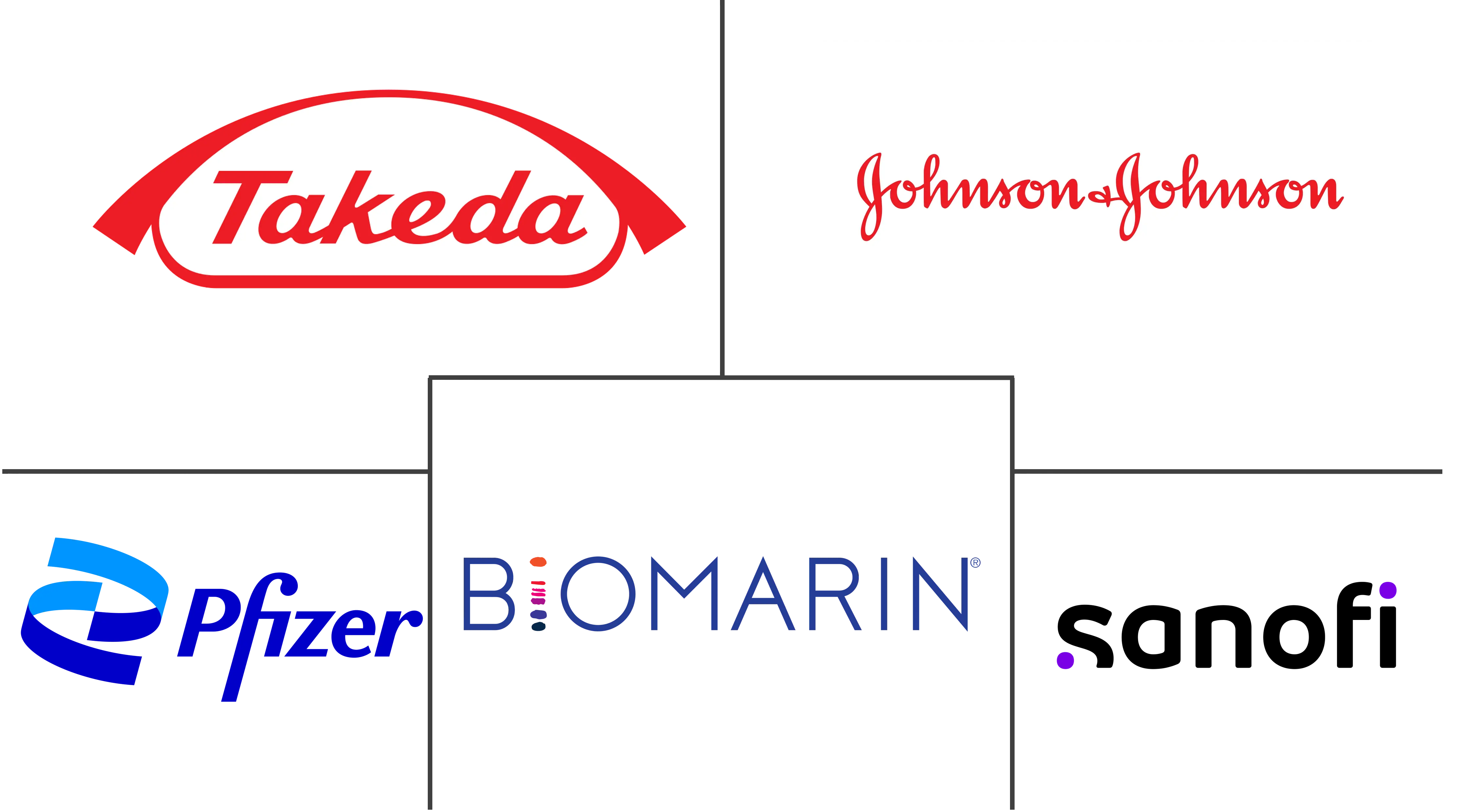
*Disclaimer: Major Players sorted in no particular order |
Lysosomal Storage Disease Treatment Market Analysis
The lysosomal storage disease treatment market is expected to register a CAGR of 8.2% during the forecast period.
The growth of lysosomal storage disease treatment is driven by increased research and development, and the spread of awareness among people about the lysosomal storage disease. Furthermore, the increasing investment in research and development also contributes to market growth. As per the study published by the National Library of Medicine, in July 2022, when viewed as a group, LSDs are much more common. The combined incidence is between 1 in 5000 to 1 in 8000. As per the same source, both ethnicity and geography play a part in the incidence of LSDs. For example, Gaucher disease (GD) occurs in 1 in 40000 to 1 in 60000 in the general population. In Eastern European Jews (Ashkenazi Jews), GD is as high as 1 in 800, and Tay-Sachs disease is as high as 1 in 3900. Niemann-Pick A and mucolipidosis IV also occur with increased frequency in this population. In the Finnish population, aspartylglucosaminuria occurs at a frequency of 1 in 18500. Thus, the increasing burden of LSDs is expected to increase the growth of the lysosomal storage disease treatment market over the forecast period.
Launching novel drugs worldwide will boost the demand for treatment of this disorder and further drive the market's revenue growth. Moreover, increasing R&D expenditure globally will also promote working on novel therapeutics and treatment of lysosomal storage diseases. For Instance, in February 2021, Genethon launched a gene therapy clinical trial for late-onset Pompe disease, led by the company Spark Therapeutics, using technologies developed at Genethon.
Moreover, awareness related to lysosomal storage diseases is crucial for patients and healthcare staff. In recent years, there has been a rise in awareness related to the treatment of Fabry disease in different countries such as the United States, United Kingdom, and others. For instance, according to National Fabry Disease Foundation (NFDF), every year 'April' is observed as Fabry Disease Awareness Month. Furthermore, other organizations that formally observe April as Fabry Disease Awareness Month include Fabry International Network (FIN), Fabry Australia, and MPS Society in the United Kingdom. In addition, during April, these organizations raise awareness of Fabry disease. This includes educating the public, patients, caregivers, and healthcare professionals. Furthermore, the awareness activities help to enhance the perception, diagnosis, and management of such diseases.
Furthermore, increasing development in enzyme replacement therapies and gene therapy will also create a lucrative opportunity for the pompe disease market in the forecasted period as these are the therapies used to treat this disorder. However, high treatment costs associated with lysosomal storage diseases may hamper the market to a certain extent.
Lysosomal Storage Disease Treatment Market Trends
Pompe Disease Segment is Expected to Hold a Major Market Share in the Lysosomal Storage Disease Treatment Market
Pompe disease is a rare disease classified as early infantile or late-onset, majorly affecting skeletal muscle, heart defects, and breathing problems.
As to the National Institute of Health, in April 2022, Pompe disease affects 1 in 40,000 individuals in the United States. Moreover, according to the study titled "Carrier frequency and predicted genetic prevalence of Pompe disease based on a general population database" Molecular Genetics and Metabolism report in June 2021, Pathogenic or Likely Pathogenic Variants (PLPVs) were found in higher proportions in East Asian and African patients with classic infantile-onset Pompe disease. In the general population, total carrier frequency (CF) and predicted genetic prevalence (pGP) was 1.3 % (1 in 77) and 1:23,232, respectively. Thus, the rising prevalence of pompe disease is anticipated to boost the growth of the market segment over the forecast period.
Moreover, product approvals and launches by the key market players with respect to the segment are anticipated to drive the market over the forecast period. For Instance, In August 2021, The US FDA approved a new enzyme replacement therapy, avalglucosidase alfa, for patients aged 1 year and older with late-onset Pompe disease.
Thus, all aforementioned factors are anticipated to drive the segment growth over the forecast period.
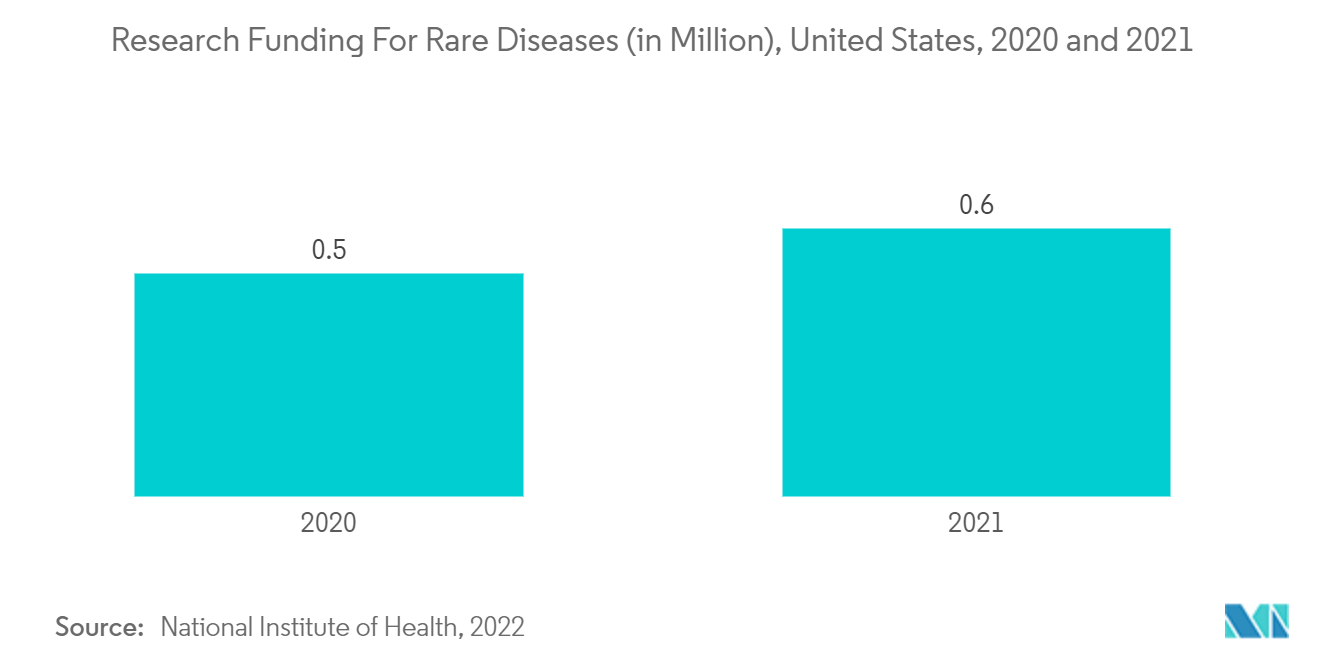
North America is Expected to Hold a Significant Share in the Market and Expected to do Same in the Forecast Period
North America is expected to hold a major market share in the global lysosomal storage disease treatment market due to the increasing incidence of lysosomal storage disorders in this region.
According to NORD, data updated in March 2021, approximately 6,000 individuals are affected with Gaucher disease in the United States. Moreover, Type 1 Gaucher disease is the most common form of the disease in western countries, making up roughly 95 percent of patients. Furthermore, increasing research and development for diagnosis and drug development for the treatment of lysosomal diseases and the presence of well-established healthcare infrastructure are also fueling the growth of the overall regional market to a large extent.
Moreover, with increasing product launches and the US FDA approval, and the activities by the Key players the market is expected to see a surge. For Instance, In August 2021, the US FDA approved Nexviazyme for intravenous infusion to treat patients 1 year of age and older with late-onset Pompe disease. Moreover, The US FDA granted Orphan Drug Designation (ODD) to AceLink Therapeutics ' AL01211 to treat Fabry disease. Such, instances are expected to boost the growth of the market over the forecast period.
Furthermore, increasing awareness about rare disorders and developed healthcare infrastructure are also expected to fuel the growth of the market in this region.
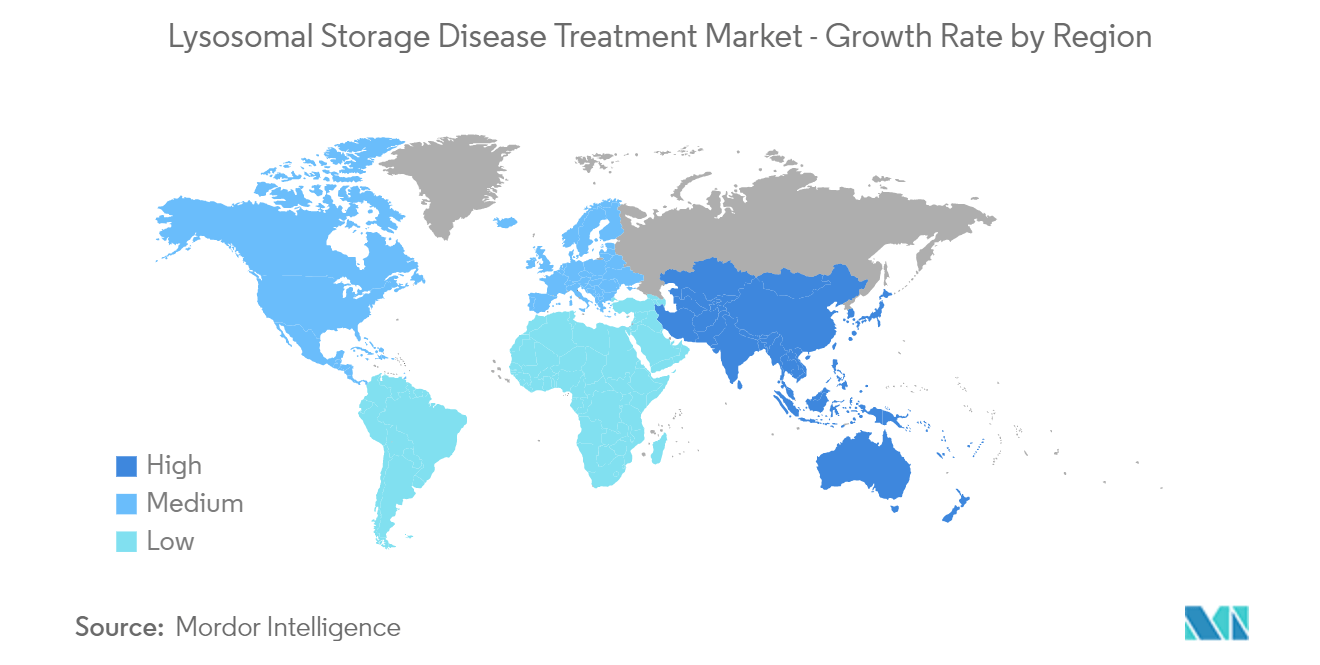
Lysosomal Storage Disease Treatment Industry Overview
The lysosomal storage disease treatment market is consolidated and consists of a few major players. In terms of market share, a few of the major players are currently dominating the market. Some of the leading market players include Pfizer Inc, Takeda Pharmaceutical Company Limited (Shire Plc), Sanofi (Genzyme Corporation), BioMarin, Johnson & Johnson (Actelion Pharmaceuticals Ltd), Amicus Therapeutics, Inc, Alexion Pharmaceuticals, Inc, Sigilon Therapeutics, Inc and Orphazyme A/S.
Lysosomal Storage Disease Treatment Market Leaders
-
Pfizer Inc
-
Takeda Pharmaceutical Company Limited (Shire Plc)
-
Sanofi (Genzyme Corporation)
-
BioMarin
-
Johnson & Johnson (Actelion Pharmaceuticals Ltd)
*Disclaimer: Major Players sorted in no particular order
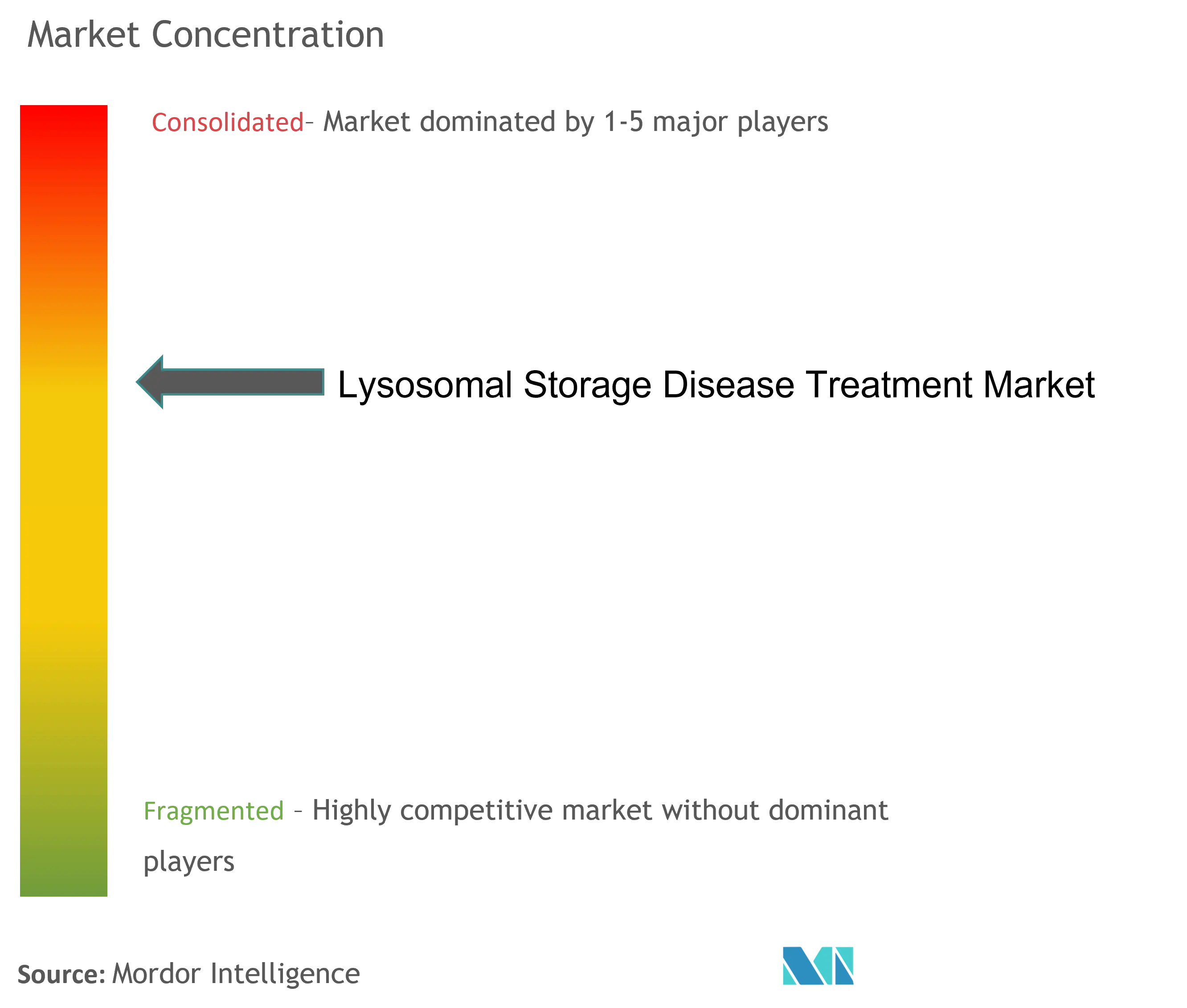
Lysosomal Storage Disease Treatment Market News
- In August 2022, the European Commission approved Galafold marketed by Amicus Therapeutics for the long-term treatment of Fabry disease patients aged 12 years and above with an amenable mutation.
- In February 2022, Maze Therapeutics, a company translating genetic insights into new precision medicines, reported new preclinical data supporting the advancement of MZE001, which aims to address Pompe disease by reducing pathologic glycogen accumulation through the inhibition of muscle glycogen synthase (GYS1).
Lysosomal Storage Disease Treatment Market Report - Table of Contents
1. INTRODUCTION
- 1.1 Study Assumptions and Market Definition
- 1.2 Scope of the Study
2. RESEARCH METHODOLOGY
3. EXECUTIVE SUMMARY
4. MARKET DYNAMICS
- 4.1 Market Overview
-
4.2 Market Drivers
- 4.2.1 Increasing Incidences of Lysosomal Diseases and Growing Awrness
- 4.2.2 Increasing Research and Development for Diagnosis and Drug Development for Treatment of Lysosomal Diseases
-
4.3 Market Restraints
- 4.3.1 High Cost of Treatment
-
4.4 Porter's Five Force Analysis
- 4.4.1 Threat of New Entrants
- 4.4.2 Bargaining Power of Buyers/Consumers
- 4.4.3 Bargaining Power of Suppliers
- 4.4.4 Threat of Substitute Products
- 4.4.5 Intensity of Competitive Rivalry
5. MARKET SEGMENTATION (Market Size by Value - USD Million)
-
5.1 By Therapy Type
- 5.1.1 Enzyme Replacement Therapy
- 5.1.1.1 Velaglucerase Alfa
- 5.1.1.2 Taliglucerase Alfa
- 5.1.1.3 Agalsidase beta
- 5.1.1.4 Laronidase
- 5.1.1.5 Imiglucerase
- 5.1.1.6 Other Enzyme Replacement Therapies
- 5.1.2 Substrate Reduction Therapy
- 5.1.2.1 Eliglustat
- 5.1.2.2 Miglustat
- 5.1.2.3 Other Substrate Reduction Therapies
-
5.2 By Application
- 5.2.1 Gaucher disease
- 5.2.2 Cystinosis
- 5.2.3 Pompe Disease
- 5.2.4 Fabry Disease
- 5.2.5 Other Applications
-
5.3 Geography
- 5.3.1 North America
- 5.3.1.1 United States
- 5.3.1.2 Canada
- 5.3.1.3 Mexico
- 5.3.2 Europe
- 5.3.2.1 Germany
- 5.3.2.2 United Kingdom
- 5.3.2.3 France
- 5.3.2.4 Italy
- 5.3.2.5 Spain
- 5.3.2.6 Rest of Europe
- 5.3.3 Asia-Pacific
- 5.3.3.1 China
- 5.3.3.2 Japan
- 5.3.3.3 India
- 5.3.3.4 Australia
- 5.3.3.5 South Korea
- 5.3.3.6 Rest of Asia-Pacific
- 5.3.4 Rest of the World
6. COMPETITIVE LANDSCAPE
-
6.1 Company Profiles
- 6.1.1 Pfizer Inc
- 6.1.2 Takeda Pharmaceutical Company Limited (Shire Plc)
- 6.1.3 Sanofi (Genzyme Corporation)
- 6.1.4 BioMarin
- 6.1.5 Johnson & Johnson (Actelion Pharmaceuticals Ltd)
- 6.1.6 Amicus Therapeutics, Inc
- 6.1.7 Alexion Pharmaceuticals, Inc
- 6.1.8 Sigilon Therapeutics, Inc
- 6.1.9 Orphazyme A/S
- *List Not Exhaustive
7. MARKET OPPORTUNITIES AND FUTURE TRENDS
** Subject To AvailablityLysosomal Storage Disease Treatment Industry Segmentation
As per the scope of the report, lysosomal storage diseases (LSDs) are inborn errors of metabolism characterized by the accumulation of substrates in excess in various organs' cells due to the defective functioning of lysosomes. They cause dysfunction of those organs where they accumulate and contribute to great morbidity and mortality. The Lysosomal Storage Disease Treatment Market is Segmented By Therapy Type (Enzyme Replacement Therapy, Substrate Reduction Therapy), By Application (Gaucher disease, Cystinosis, Pompe Disease, Fabry Disease, and Other Applications), and Geography (North America, Europe, Asia-Pacific, and Rest of the World). The report offers the value (in USD million) for the above segments.
| By Therapy Type | Enzyme Replacement Therapy | Velaglucerase Alfa |
| Taliglucerase Alfa | ||
| Agalsidase beta | ||
| Laronidase | ||
| Imiglucerase | ||
| Other Enzyme Replacement Therapies | ||
| By Therapy Type | Substrate Reduction Therapy | Eliglustat |
| Miglustat | ||
| Other Substrate Reduction Therapies | ||
| By Application | Gaucher disease | |
| Cystinosis | ||
| Pompe Disease | ||
| Fabry Disease | ||
| Other Applications | ||
| Geography | North America | United States |
| Canada | ||
| Mexico | ||
| Geography | Europe | Germany |
| United Kingdom | ||
| France | ||
| Italy | ||
| Spain | ||
| Rest of Europe | ||
| Geography | Asia-Pacific | China |
| Japan | ||
| India | ||
| Australia | ||
| South Korea | ||
| Rest of Asia-Pacific | ||
| Geography | Rest of the World |
Lysosomal Storage Disease Treatment Market Research FAQs
What is the current Lysosomal Storage Disease Treatment Market size?
The Lysosomal Storage Disease Treatment Market is projected to register a CAGR of 8.20% during the forecast period (2024-2029)
Who are the key players in Lysosomal Storage Disease Treatment Market?
Pfizer Inc, Takeda Pharmaceutical Company Limited (Shire Plc), Sanofi (Genzyme Corporation), BioMarin and Johnson & Johnson (Actelion Pharmaceuticals Ltd) are the major companies operating in the Lysosomal Storage Disease Treatment Market.
Which is the fastest growing region in Lysosomal Storage Disease Treatment Market?
Asia Pacific is estimated to grow at the highest CAGR over the forecast period (2024-2029).
Which region has the biggest share in Lysosomal Storage Disease Treatment Market?
In 2024, the North America accounts for the largest market share in Lysosomal Storage Disease Treatment Market.
What years does this Lysosomal Storage Disease Treatment Market cover?
The report covers the Lysosomal Storage Disease Treatment Market historical market size for years: 2021, 2022 and 2023. The report also forecasts the Lysosomal Storage Disease Treatment Market size for years: 2024, 2025, 2026, 2027, 2028 and 2029.
Lysosomal Storage Disease Treatment Industry Report
Statistics for the 2024 Lysosomal Storage Disease Treatment market share, size and revenue growth rate, created by Mordor Intelligence™ Industry Reports. Lysosomal Storage Disease Treatment analysis includes a market forecast outlook 2029 and historical overview. Get a sample of this industry analysis as a free report PDF download.



